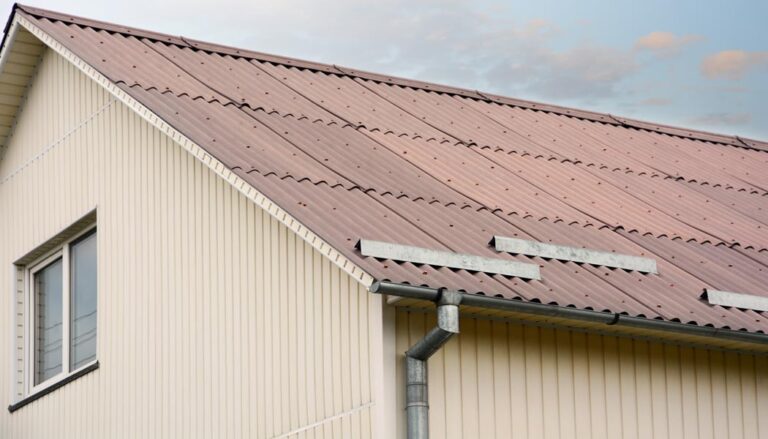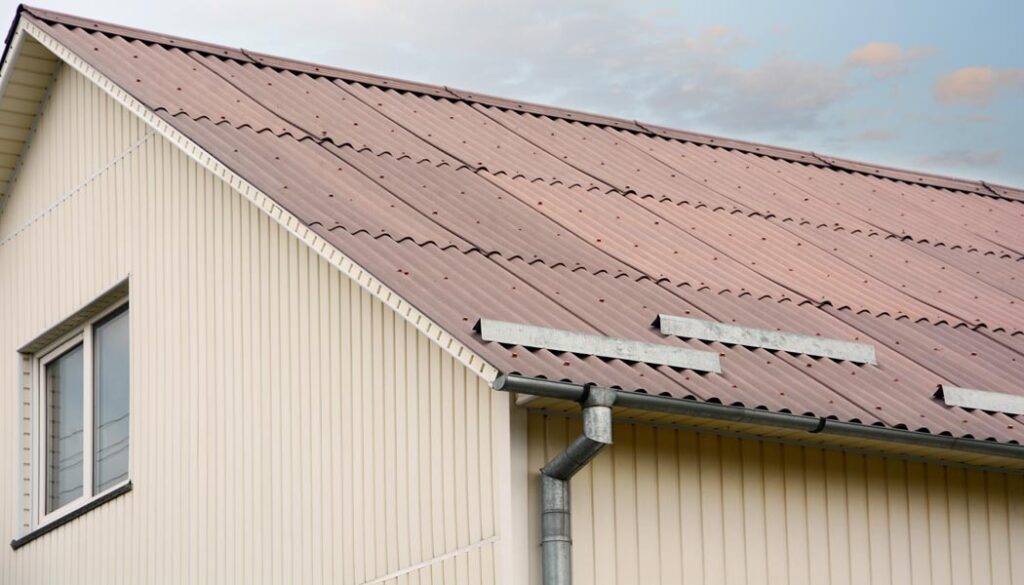
Can You Paint Asbestos Siding? (Exploring the Pros & Cons)
Yes, it is possible to safely paint asbestos siding, but it is essential to approach the task with caution and follow specific guidelines to minimize any potential health risks.

While we strive to provide you with valuable information about this, it is essential to note that we are not advocating for any particular action regarding asbestos siding. Your safety and the safety of those around you should always be a top priority. Therefore, it is crucial to thoroughly understand the risks and consult with professionals before making any decisions related to asbestos-containing materials.
What Is Asbestos?
Asbestos is a mineral fiber that has been extensively used in various industries for its heat resistance, durability, and insulating properties.
Asbestos siding refers to its use in constructing exterior walls of buildings. It was popular in the mid-20th century due to its fire resistance, weather durability, and affordability. Asbestos siding typically took the form of cement sheets or shingles installed on the exterior of houses.
Asbestos siding has several properties that made it desirable for construction purposes. It is highly resistant to heat, making it effective in preventing fires from spreading. It is also resistant to rot, insects, and harsh weather conditions, making it a durable choice for exterior applications. Furthermore, asbestos siding provides good insulation, helping to regulate temperature and reduce energy costs.
While asbestos has desirable properties for construction, it poses significant health risks. When asbestos-containing materials are disturbed or damaged, tiny fibers can become airborne and easily inhaled. Prolonged inhalation or ingestion of these fibers can lead to various health issues, including lung diseases such as asbestosis, lung cancer, and mesothelioma (a rare and aggressive form of cancer).
Due to these severe health risks, asbestos use has been heavily regulated or banned in many countries. Proper handling, removal, and disposal of asbestos-containing materials are crucial to minimize exposure risks. If you suspect the presence of asbestos in your home, it is recommended to consult professionals for assessment and safe remediation.
Can You Paint Asbestos Siding?
Yes, you can paint asbestos siding. However, it is important to note that dealing with asbestos requires caution and adherence to safety guidelines. If the siding is in good condition and not crumbling or damaged, painting it can be a viable option to refresh its appearance.
To safely paint asbestos siding, it is crucial to follow specific precautions. Before beginning, consult with a professional who has experience working with asbestos. They can provide guidance and ensure that all safety measures are taken. It is essential to wear protective clothing, including a respirator and disposable coveralls, to minimize exposure to asbestos fibers.
Prior to painting, thoroughly clean the siding to remove any dirt or loose particles. Use a mild detergent and a soft brush or sponge to avoid damaging the siding. Allow the siding to dry completely before proceeding. Choose a high-quality paint specifically designed for exterior surfaces. Apply the paint evenly, following the manufacturer’s instructions.
Remember, handling and disposing of asbestos-containing materials require strict adherence to safety regulations and guidelines established by local authorities or environmental agencies.
Painting Asbestos Siding Vs Replacing It: What to Do
When deciding between painting asbestos siding and replacing it, several factors come into play. it’s important to weigh the pros and cons of each option. It’s crucial to note that asbestos is a hazardous material, and its handling and disposal should be done following appropriate safety regulations. Here are the pros and cons of both painting asbestos siding and replacing it:
Painting Asbestos Siding:
Pros:
- Cost-effective
- Aesthetically pleasing
- Preservation of asbestos fibers
- Minimal disruption during the process
Cons:
- Temporary solution
- Safety concerns for damaged siding
- Potential regulatory restrictions
Replacing Asbestos Siding:
Pros:
- Eliminates health risks
- Improved energy efficiency
- Durability
- Reduced maintenance
Cons:
- Higher cost
- Disruption during construction
- Potential structural alterations
Final Suggestion:
If the asbestos siding is in good condition, undamaged, and not at risk of being disturbed, painting can be a cost-effective option to improve its appearance. However, it’s important to remember that painting is a temporary solution and does not address the asbestos hazard.
If the asbestos siding is damaged, deteriorating, or poses a potential risk, it is advisable to opt for complete replacement. This ensures the elimination of asbestos-related health hazards, provides a long-term solution, and allows for the installation of more energy-efficient and visually appealing materials.
Factors to Consider Before Painting Asbestos Siding
Before painting asbestos siding, there are several factors to consider in order to ensure safety and compliance with legal regulations. Here are the key points to keep in mind:
Legal regulations regarding asbestos:
Familiarize yourself with local and national regulations: Research and understand the legal requirements and regulations regarding asbestos in your region. These regulations may include guidelines for handling, abatement, and painting of asbestos-containing materials (ACMs).
Verify permissible activities: Determine whether painting asbestos siding is allowed under the applicable regulations. Some jurisdictions may prohibit certain activities, such as disturbing or encapsulating asbestos.
Consult with local authorities: Contact local environmental or health agencies to seek guidance on the specific requirements and regulations governing asbestos in your area. They can provide valuable information and direct you to relevant resources.
Assessing the condition of asbestos siding:
Visual inspection: Evaluate the current condition of the asbestos siding. Look for signs of damage, such as cracks, chips, or deterioration. Ensure that the siding is in stable condition and not friable (easily crumbled or damaged).
Consider the age of the siding: The age of the asbestos siding can affect its stability. Older materials may be more prone to damage or deterioration.
Assess potential risks: Determine whether the siding poses any immediate risks, such as releasing asbestos fibers into the air. If the siding is significantly damaged, it may require professional abatement rather than painting.
Hiring a professional for inspection and testing:
Engage a certified asbestos professional: Seek the expertise of a qualified professional who specializes in asbestos inspection and testing. They will assess the condition of the siding, conduct proper sampling, and analyze the presence of asbestos fibers.
Testing for asbestos content: Asbestos cannot be identified through visual inspection alone. A professional can collect samples from the siding and have them analyzed in a laboratory to determine the asbestos content.
Professional recommendations: Based on their findings, the professional will provide recommendations on whether painting is a suitable option or if other measures, such as encapsulation or abatement, are necessary.
Abiding by professional advice: It is crucial to follow the recommendations of the certified professional to ensure the safe handling and management of asbestos-containing materials.
How to Paint Over Asbestos Siding?
If you have verified that it is permissible to paint over asbestos siding in your area and have taken the necessary precautions, here is a general step-by-step guide for painting over asbestos siding. Please note that it is crucial to consult with professionals or experts in asbestos abatement to ensure the safety of yourself and others.
Safety Precautions:
- Wear personal protective equipment (PPE) such as disposable coveralls, gloves, goggles, and a respirator with appropriate filters.
- Set up a containment area around the work area using plastic sheeting and duct tape to prevent the spread of asbestos fibers.
- Seal off all windows, doors, and vents in the area to prevent cross-contamination.
Surface Preparation:
- Inspect the asbestos siding for any damage or deterioration. If there are significant issues, it may be necessary to hire professionals to repair or replace the siding.
- Clean the surface of the siding thoroughly to remove dirt, dust, and any loose debris. Use a mild detergent and a soft brush, avoiding aggressive scrubbing that can damage the siding.
Priming:
- Apply a high-quality primer specifically designed for asbestos siding. Choose a primer that is compatible with the type of paint you intend to use.
- Follow the manufacturer’s instructions for application, including recommended drying times between coats if multiple coats are required.
Painting:
- Once the primer has dried, apply the paint using a brush, roller, or sprayer, according to your preference and the manufacturer’s recommendations.
- Start at the top and work your way down, applying an even coat of paint to the siding.
- Allow the first coat to dry completely before applying additional coats, if necessary. Follow the manufacturer’s instructions for drying times.
Cleanup:
- Clean up all debris and materials used during the painting process, following proper asbestos waste disposal guidelines provided by your local authorities.
- Remove the plastic sheeting used for containment and dispose of it properly.
- Thoroughly clean any PPE used, or if disposable, dispose of it as hazardous waste.
Again, it is crucial to emphasize that working with asbestos can be extremely dangerous, and it is strongly recommended to consult with professionals who are trained in asbestos abatement before attempting any work involving asbestos materials. They can provide specific guidance and ensure that all necessary safety measures are followed to protect yourself and others from asbestos exposure.
What Paint to Use Over Asbestos?
Latex or acrylic-based encapsulation paints can be used over asbestos-containing materials in some situations.
These paints are designed to create a sealant barrier, preventing the release of asbestos fibers. However, it is crucial to follow the guidelines and recommendations of the specific paint manufacturer and consult with local experts to ensure compliance with regulations and safety standards in your area. Proper containment and handling of asbestos materials should always be a priority.
What Primer to Use on Asbestos Siding?
When working with asbestos siding, it is advisable to use a latex-based primer designed for encapsulating asbestos fibers.
Another recommended primer is “Fiberlock LBC (Lead Barrier Compound) Asbestos Encapsulant.” This primer is specifically designed to adhere to asbestos surfaces and provide a protective barrier to prevent the release of asbestos fibers.
Of course always look for a primer labeled for use on asbestos-containing materials, as it will provide a strong bond and help prevent the release of hazardous fibers.
How Much Does It Cost to Paint Asbestos Siding?
The cost to paint asbestos siding can vary depending on various factors such as the size of the project, the condition of the siding, and the location.
On average, homeowners can expect to spend between $2,000 and $5,000 for a professional paint job on asbestos siding.
Disturbing asbestos-containing materials can be hazardous. Make sure to consult with asbestos remediation experts for proper handling and painting procedures.
Final Thoughts
With proper safety measures and careful consideration, painting asbestos siding can be a feasible option.
By following our guidelines and taking the necessary precautions, revitalize the appearance of your home. It is necessary to consult professionals for asbestos abatement. Experts can ensure compliance with local regulations. Seek specific advice for your situation.
